TransAsia Flight 235 Accident: Causes, Consequences, and Prevention
VerifiedAdded on 2023/03/21
|13
|2460
|62
Case Study
AI Summary
This case study examines the TransAsia Flight 235 accident, where an ATR72-212A aircraft crashed into the Keelung River in 2015, resulting in 43 fatalities and 13 serious injuries. The report details the chain of events leading to the crash, starting with an engine failure shortly after takeoff, followed by the accidental shutdown of the second engine due to pilot error. The primary cause was identified as engine failure, with the secondary cause being the incorrect shutdown of the functioning engine. The report also discusses the consequences of the accident and offers recommendations for preventing similar incidents in the future, including enhanced training for flight crews on emergency procedures, the implementation of comprehensive safety checklists, and improved regulatory oversight by the Civil Aeronautics Administration. The analysis emphasizes the importance of adhering to established safety protocols and addressing potential deficiencies in airline safety management.
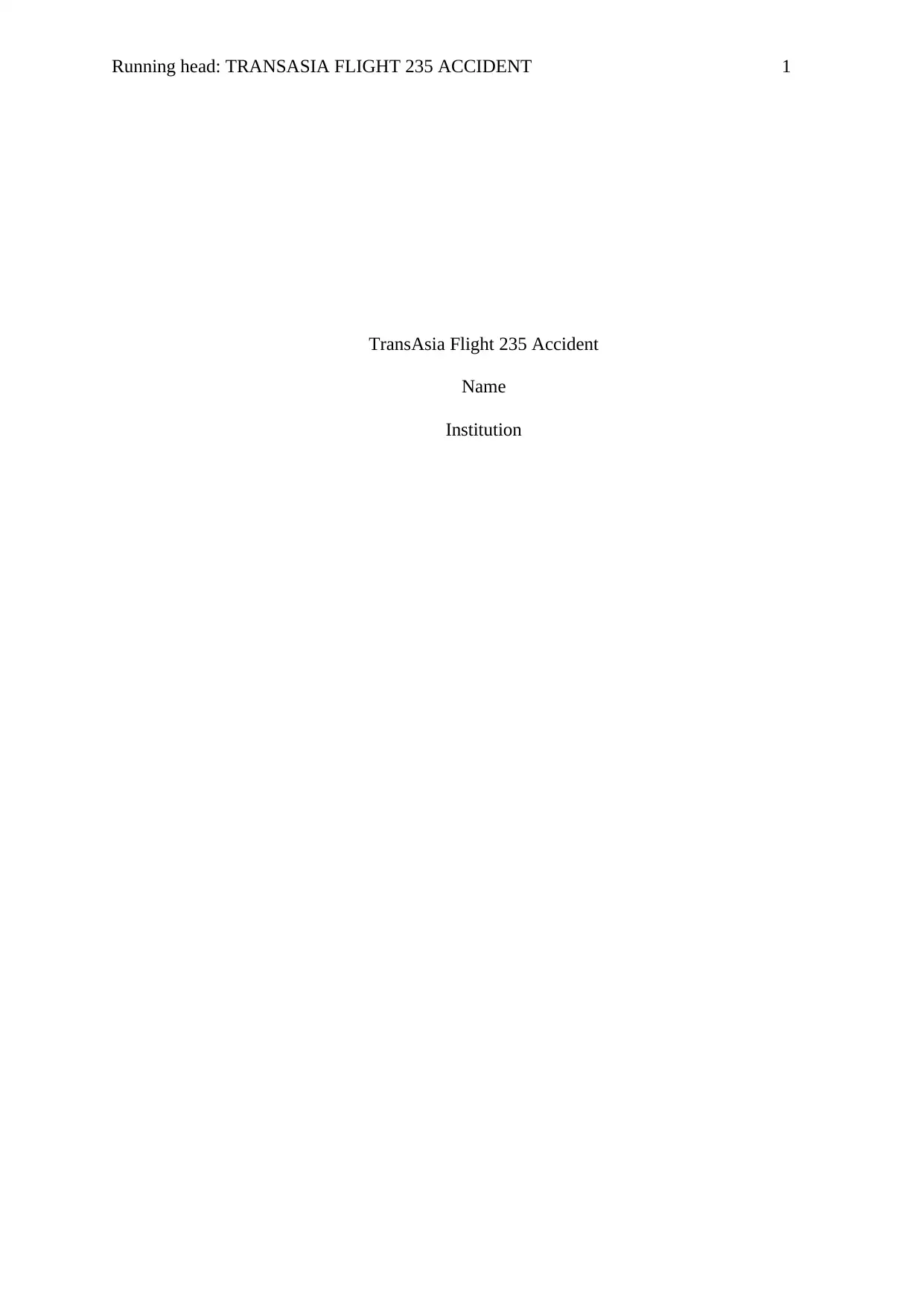
Running head: TRANSASIA FLIGHT 235 ACCIDENT 1
TransAsia Flight 235 Accident
Name
Institution
TransAsia Flight 235 Accident
Name
Institution
Paraphrase This Document
Need a fresh take? Get an instant paraphrase of this document with our AI Paraphraser
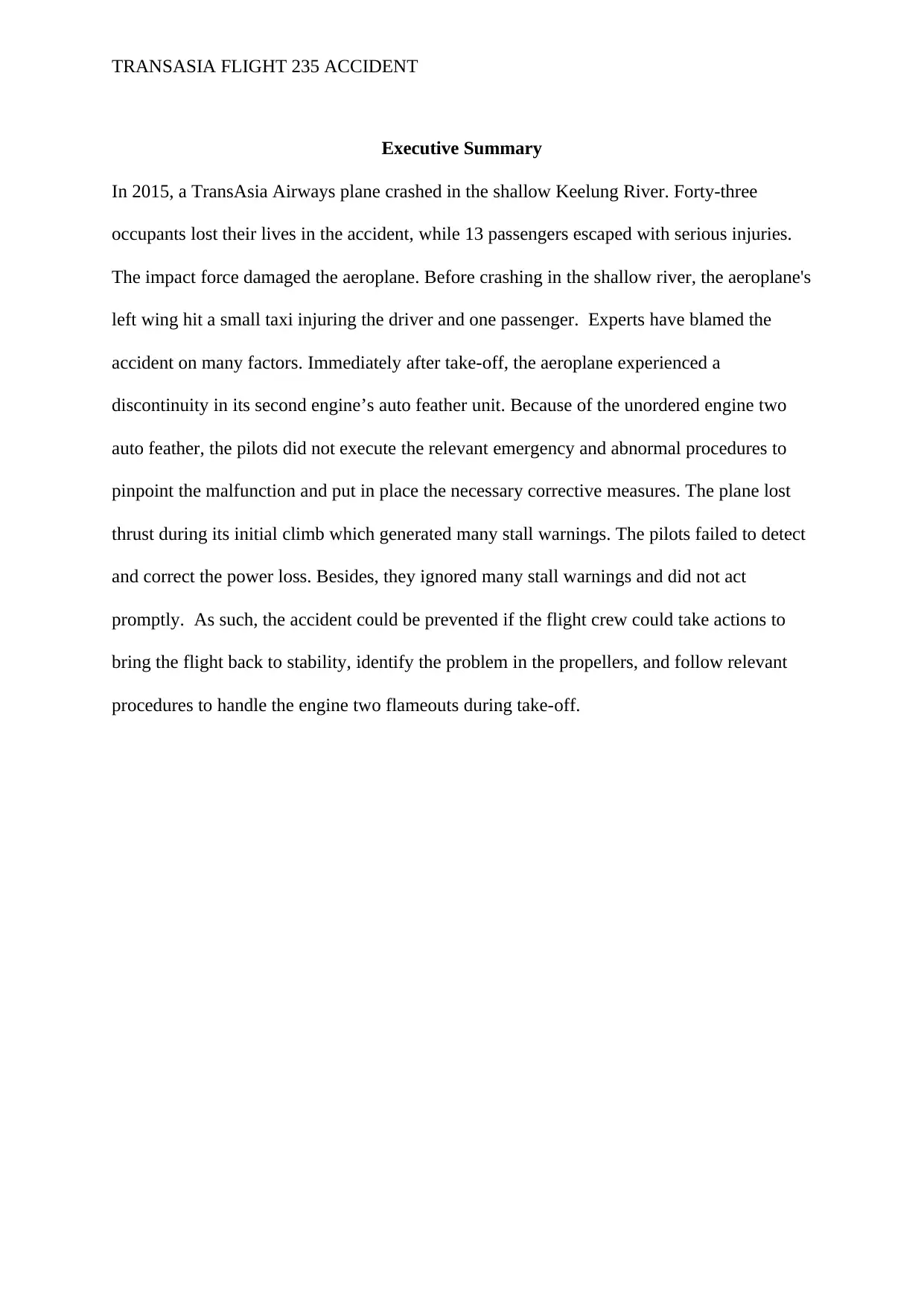
TRANSASIA FLIGHT 235 ACCIDENT
Executive Summary
In 2015, a TransAsia Airways plane crashed in the shallow Keelung River. Forty-three
occupants lost their lives in the accident, while 13 passengers escaped with serious injuries.
The impact force damaged the aeroplane. Before crashing in the shallow river, the aeroplane's
left wing hit a small taxi injuring the driver and one passenger. Experts have blamed the
accident on many factors. Immediately after take-off, the aeroplane experienced a
discontinuity in its second engine’s auto feather unit. Because of the unordered engine two
auto feather, the pilots did not execute the relevant emergency and abnormal procedures to
pinpoint the malfunction and put in place the necessary corrective measures. The plane lost
thrust during its initial climb which generated many stall warnings. The pilots failed to detect
and correct the power loss. Besides, they ignored many stall warnings and did not act
promptly. As such, the accident could be prevented if the flight crew could take actions to
bring the flight back to stability, identify the problem in the propellers, and follow relevant
procedures to handle the engine two flameouts during take-off.
Executive Summary
In 2015, a TransAsia Airways plane crashed in the shallow Keelung River. Forty-three
occupants lost their lives in the accident, while 13 passengers escaped with serious injuries.
The impact force damaged the aeroplane. Before crashing in the shallow river, the aeroplane's
left wing hit a small taxi injuring the driver and one passenger. Experts have blamed the
accident on many factors. Immediately after take-off, the aeroplane experienced a
discontinuity in its second engine’s auto feather unit. Because of the unordered engine two
auto feather, the pilots did not execute the relevant emergency and abnormal procedures to
pinpoint the malfunction and put in place the necessary corrective measures. The plane lost
thrust during its initial climb which generated many stall warnings. The pilots failed to detect
and correct the power loss. Besides, they ignored many stall warnings and did not act
promptly. As such, the accident could be prevented if the flight crew could take actions to
bring the flight back to stability, identify the problem in the propellers, and follow relevant
procedures to handle the engine two flameouts during take-off.
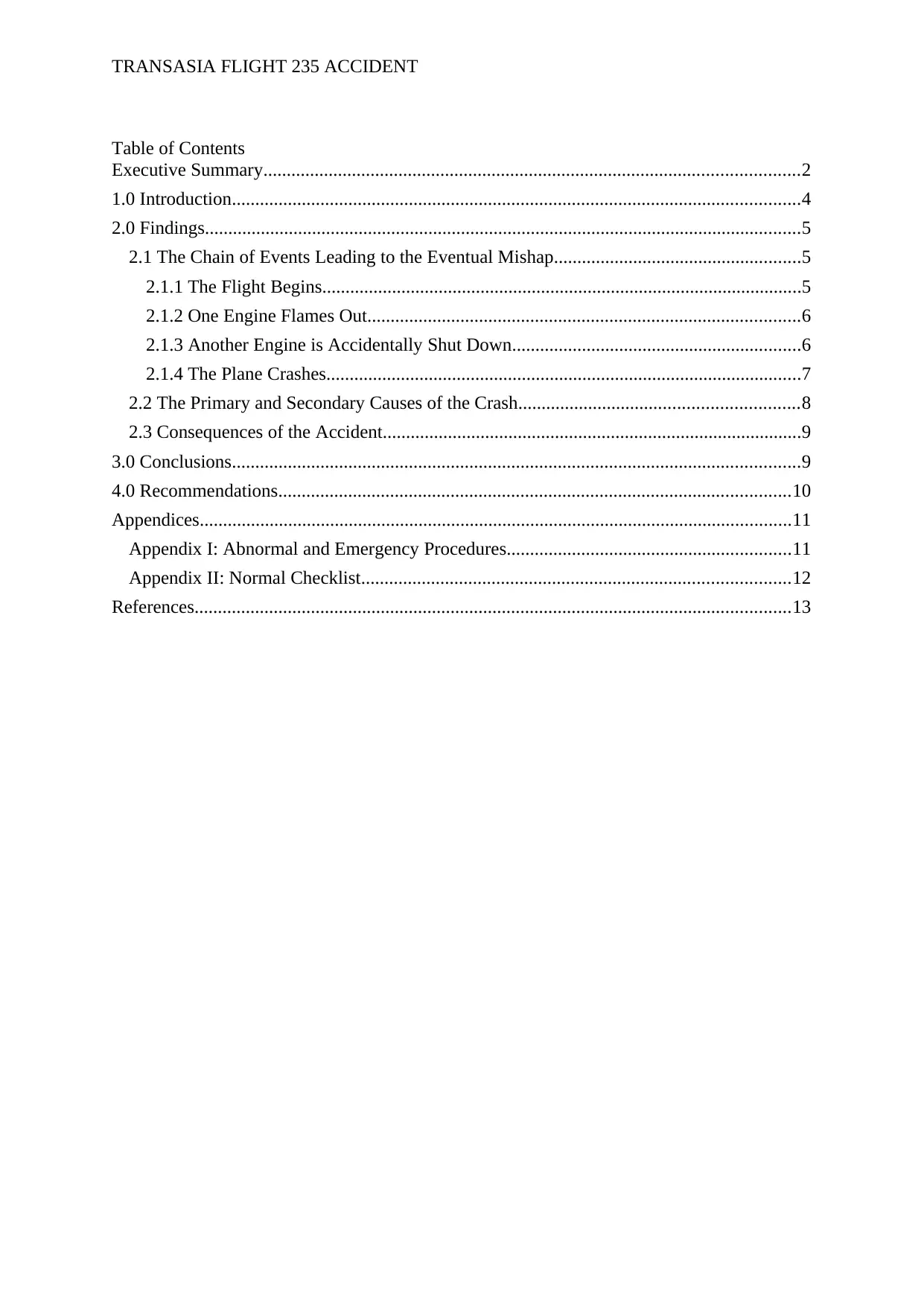
TRANSASIA FLIGHT 235 ACCIDENT
Table of Contents
Executive Summary...................................................................................................................2
1.0 Introduction..........................................................................................................................4
2.0 Findings................................................................................................................................5
2.1 The Chain of Events Leading to the Eventual Mishap.....................................................5
2.1.1 The Flight Begins.......................................................................................................5
2.1.2 One Engine Flames Out.............................................................................................6
2.1.3 Another Engine is Accidentally Shut Down..............................................................6
2.1.4 The Plane Crashes......................................................................................................7
2.2 The Primary and Secondary Causes of the Crash............................................................8
2.3 Consequences of the Accident..........................................................................................9
3.0 Conclusions..........................................................................................................................9
4.0 Recommendations..............................................................................................................10
Appendices...............................................................................................................................11
Appendix I: Abnormal and Emergency Procedures.............................................................11
Appendix II: Normal Checklist............................................................................................12
References................................................................................................................................13
Table of Contents
Executive Summary...................................................................................................................2
1.0 Introduction..........................................................................................................................4
2.0 Findings................................................................................................................................5
2.1 The Chain of Events Leading to the Eventual Mishap.....................................................5
2.1.1 The Flight Begins.......................................................................................................5
2.1.2 One Engine Flames Out.............................................................................................6
2.1.3 Another Engine is Accidentally Shut Down..............................................................6
2.1.4 The Plane Crashes......................................................................................................7
2.2 The Primary and Secondary Causes of the Crash............................................................8
2.3 Consequences of the Accident..........................................................................................9
3.0 Conclusions..........................................................................................................................9
4.0 Recommendations..............................................................................................................10
Appendices...............................................................................................................................11
Appendix I: Abnormal and Emergency Procedures.............................................................11
Appendix II: Normal Checklist............................................................................................12
References................................................................................................................................13
⊘ This is a preview!⊘
Do you want full access?
Subscribe today to unlock all pages.

Trusted by 1+ million students worldwide
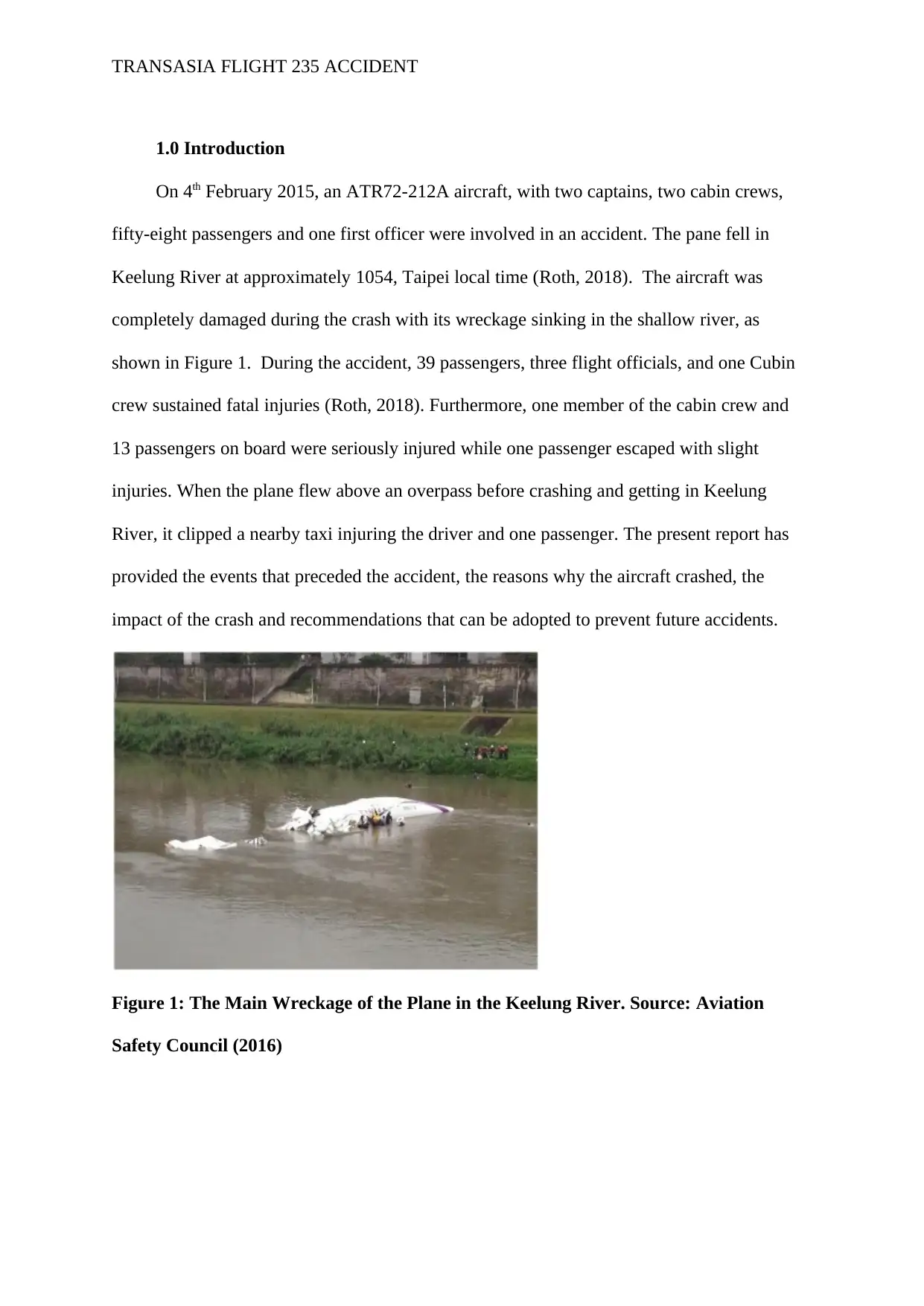
TRANSASIA FLIGHT 235 ACCIDENT
1.0 Introduction
On 4th February 2015, an ATR72-212A aircraft, with two captains, two cabin crews,
fifty-eight passengers and one first officer were involved in an accident. The pane fell in
Keelung River at approximately 1054, Taipei local time (Roth, 2018). The aircraft was
completely damaged during the crash with its wreckage sinking in the shallow river, as
shown in Figure 1. During the accident, 39 passengers, three flight officials, and one Cubin
crew sustained fatal injuries (Roth, 2018). Furthermore, one member of the cabin crew and
13 passengers on board were seriously injured while one passenger escaped with slight
injuries. When the plane flew above an overpass before crashing and getting in Keelung
River, it clipped a nearby taxi injuring the driver and one passenger. The present report has
provided the events that preceded the accident, the reasons why the aircraft crashed, the
impact of the crash and recommendations that can be adopted to prevent future accidents.
Figure 1: The Main Wreckage of the Plane in the Keelung River. Source: Aviation
Safety Council (2016)
1.0 Introduction
On 4th February 2015, an ATR72-212A aircraft, with two captains, two cabin crews,
fifty-eight passengers and one first officer were involved in an accident. The pane fell in
Keelung River at approximately 1054, Taipei local time (Roth, 2018). The aircraft was
completely damaged during the crash with its wreckage sinking in the shallow river, as
shown in Figure 1. During the accident, 39 passengers, three flight officials, and one Cubin
crew sustained fatal injuries (Roth, 2018). Furthermore, one member of the cabin crew and
13 passengers on board were seriously injured while one passenger escaped with slight
injuries. When the plane flew above an overpass before crashing and getting in Keelung
River, it clipped a nearby taxi injuring the driver and one passenger. The present report has
provided the events that preceded the accident, the reasons why the aircraft crashed, the
impact of the crash and recommendations that can be adopted to prevent future accidents.
Figure 1: The Main Wreckage of the Plane in the Keelung River. Source: Aviation
Safety Council (2016)
Paraphrase This Document
Need a fresh take? Get an instant paraphrase of this document with our AI Paraphraser
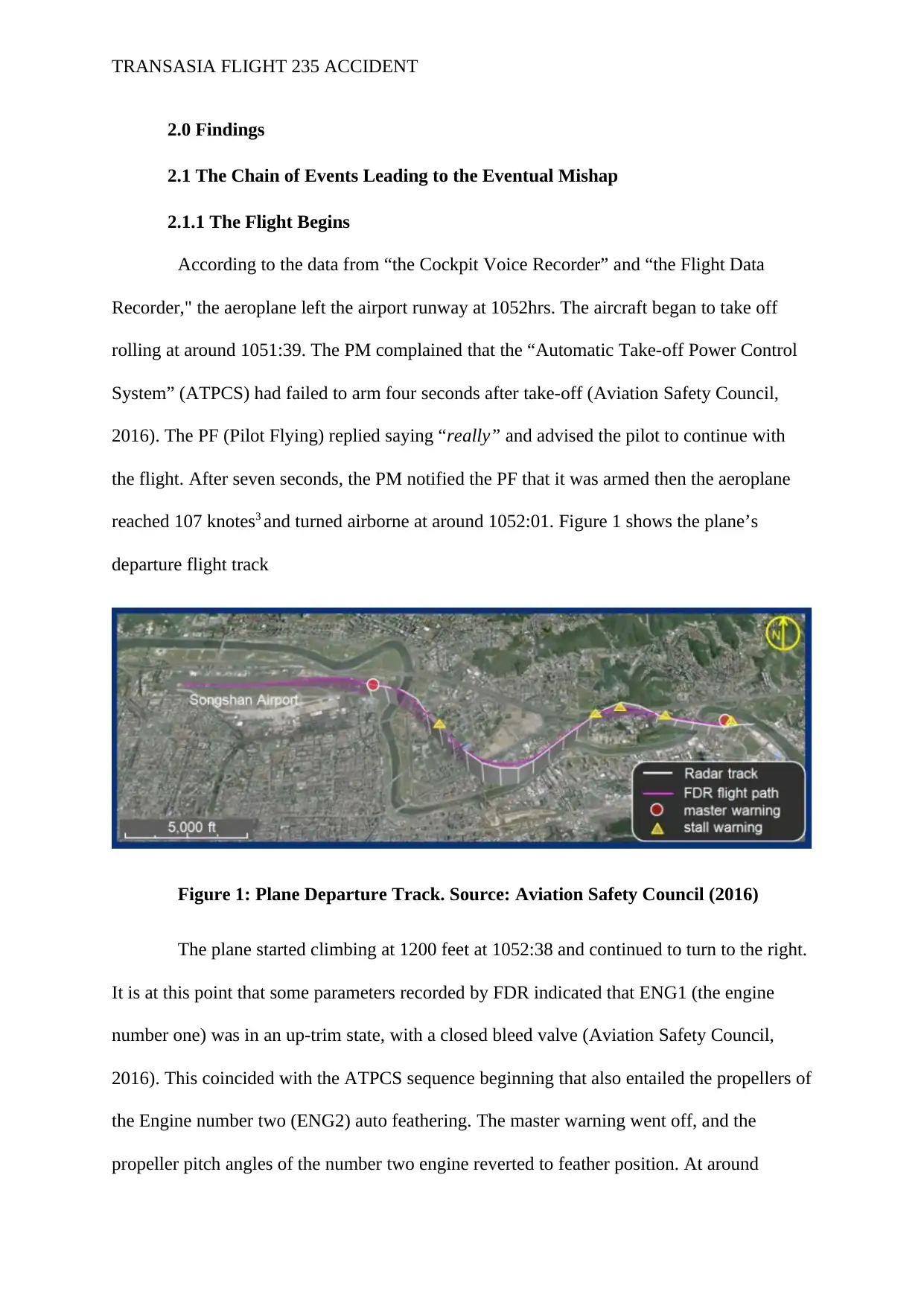
TRANSASIA FLIGHT 235 ACCIDENT
2.0 Findings
2.1 The Chain of Events Leading to the Eventual Mishap
2.1.1 The Flight Begins
According to the data from “the Cockpit Voice Recorder” and “the Flight Data
Recorder," the aeroplane left the airport runway at 1052hrs. The aircraft began to take off
rolling at around 1051:39. The PM complained that the “Automatic Take-off Power Control
System” (ATPCS) had failed to arm four seconds after take-off (Aviation Safety Council,
2016). The PF (Pilot Flying) replied saying “really” and advised the pilot to continue with
the flight. After seven seconds, the PM notified the PF that it was armed then the aeroplane
reached 107 knotes3 and turned airborne at around 1052:01. Figure 1 shows the plane’s
departure flight track
Figure 1: Plane Departure Track. Source: Aviation Safety Council (2016)
The plane started climbing at 1200 feet at 1052:38 and continued to turn to the right.
It is at this point that some parameters recorded by FDR indicated that ENG1 (the engine
number one) was in an up-trim state, with a closed bleed valve (Aviation Safety Council,
2016). This coincided with the ATPCS sequence beginning that also entailed the propellers of
the Engine number two (ENG2) auto feathering. The master warning went off, and the
propeller pitch angles of the number two engine reverted to feather position. At around
2.0 Findings
2.1 The Chain of Events Leading to the Eventual Mishap
2.1.1 The Flight Begins
According to the data from “the Cockpit Voice Recorder” and “the Flight Data
Recorder," the aeroplane left the airport runway at 1052hrs. The aircraft began to take off
rolling at around 1051:39. The PM complained that the “Automatic Take-off Power Control
System” (ATPCS) had failed to arm four seconds after take-off (Aviation Safety Council,
2016). The PF (Pilot Flying) replied saying “really” and advised the pilot to continue with
the flight. After seven seconds, the PM notified the PF that it was armed then the aeroplane
reached 107 knotes3 and turned airborne at around 1052:01. Figure 1 shows the plane’s
departure flight track
Figure 1: Plane Departure Track. Source: Aviation Safety Council (2016)
The plane started climbing at 1200 feet at 1052:38 and continued to turn to the right.
It is at this point that some parameters recorded by FDR indicated that ENG1 (the engine
number one) was in an up-trim state, with a closed bleed valve (Aviation Safety Council,
2016). This coincided with the ATPCS sequence beginning that also entailed the propellers of
the Engine number two (ENG2) auto feathering. The master warning went off, and the
propeller pitch angles of the number two engine reverted to feather position. At around
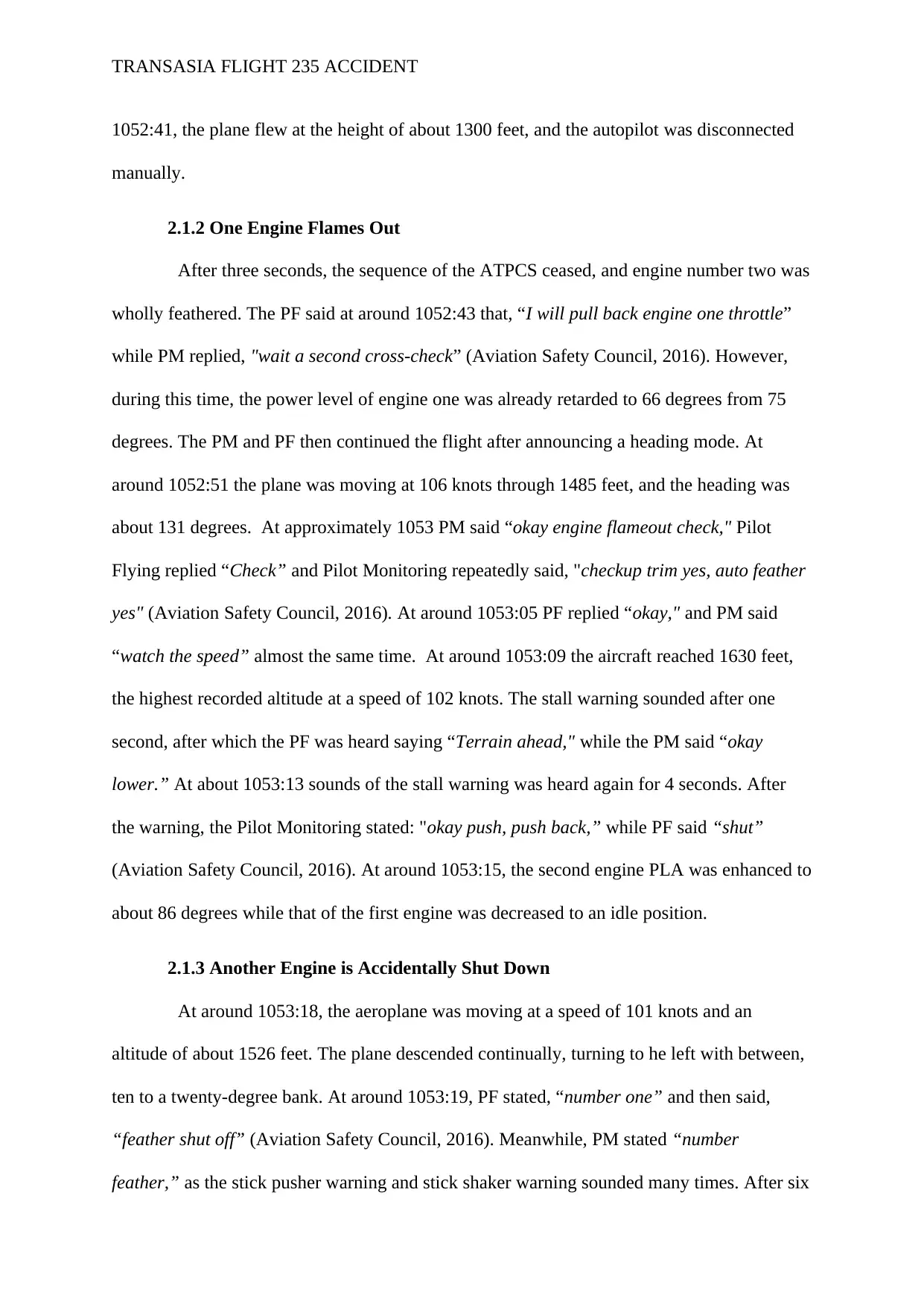
TRANSASIA FLIGHT 235 ACCIDENT
1052:41, the plane flew at the height of about 1300 feet, and the autopilot was disconnected
manually.
2.1.2 One Engine Flames Out
After three seconds, the sequence of the ATPCS ceased, and engine number two was
wholly feathered. The PF said at around 1052:43 that, “I will pull back engine one throttle”
while PM replied, "wait a second cross-check” (Aviation Safety Council, 2016). However,
during this time, the power level of engine one was already retarded to 66 degrees from 75
degrees. The PM and PF then continued the flight after announcing a heading mode. At
around 1052:51 the plane was moving at 106 knots through 1485 feet, and the heading was
about 131 degrees. At approximately 1053 PM said “okay engine flameout check," Pilot
Flying replied “Check” and Pilot Monitoring repeatedly said, "checkup trim yes, auto feather
yes" (Aviation Safety Council, 2016). At around 1053:05 PF replied “okay," and PM said
“watch the speed” almost the same time. At around 1053:09 the aircraft reached 1630 feet,
the highest recorded altitude at a speed of 102 knots. The stall warning sounded after one
second, after which the PF was heard saying “Terrain ahead," while the PM said “okay
lower.” At about 1053:13 sounds of the stall warning was heard again for 4 seconds. After
the warning, the Pilot Monitoring stated: "okay push, push back,” while PF said “shut”
(Aviation Safety Council, 2016). At around 1053:15, the second engine PLA was enhanced to
about 86 degrees while that of the first engine was decreased to an idle position.
2.1.3 Another Engine is Accidentally Shut Down
At around 1053:18, the aeroplane was moving at a speed of 101 knots and an
altitude of about 1526 feet. The plane descended continually, turning to he left with between,
ten to a twenty-degree bank. At around 1053:19, PF stated, “number one” and then said,
“feather shut off” (Aviation Safety Council, 2016). Meanwhile, PM stated “number
feather,” as the stick pusher warning and stick shaker warning sounded many times. After six
1052:41, the plane flew at the height of about 1300 feet, and the autopilot was disconnected
manually.
2.1.2 One Engine Flames Out
After three seconds, the sequence of the ATPCS ceased, and engine number two was
wholly feathered. The PF said at around 1052:43 that, “I will pull back engine one throttle”
while PM replied, "wait a second cross-check” (Aviation Safety Council, 2016). However,
during this time, the power level of engine one was already retarded to 66 degrees from 75
degrees. The PM and PF then continued the flight after announcing a heading mode. At
around 1052:51 the plane was moving at 106 knots through 1485 feet, and the heading was
about 131 degrees. At approximately 1053 PM said “okay engine flameout check," Pilot
Flying replied “Check” and Pilot Monitoring repeatedly said, "checkup trim yes, auto feather
yes" (Aviation Safety Council, 2016). At around 1053:05 PF replied “okay," and PM said
“watch the speed” almost the same time. At around 1053:09 the aircraft reached 1630 feet,
the highest recorded altitude at a speed of 102 knots. The stall warning sounded after one
second, after which the PF was heard saying “Terrain ahead," while the PM said “okay
lower.” At about 1053:13 sounds of the stall warning was heard again for 4 seconds. After
the warning, the Pilot Monitoring stated: "okay push, push back,” while PF said “shut”
(Aviation Safety Council, 2016). At around 1053:15, the second engine PLA was enhanced to
about 86 degrees while that of the first engine was decreased to an idle position.
2.1.3 Another Engine is Accidentally Shut Down
At around 1053:18, the aeroplane was moving at a speed of 101 knots and an
altitude of about 1526 feet. The plane descended continually, turning to he left with between,
ten to a twenty-degree bank. At around 1053:19, PF stated, “number one” and then said,
“feather shut off” (Aviation Safety Council, 2016). Meanwhile, PM stated “number
feather,” as the stick pusher warning and stick shaker warning sounded many times. After six
⊘ This is a preview!⊘
Do you want full access?
Subscribe today to unlock all pages.

Trusted by 1+ million students worldwide
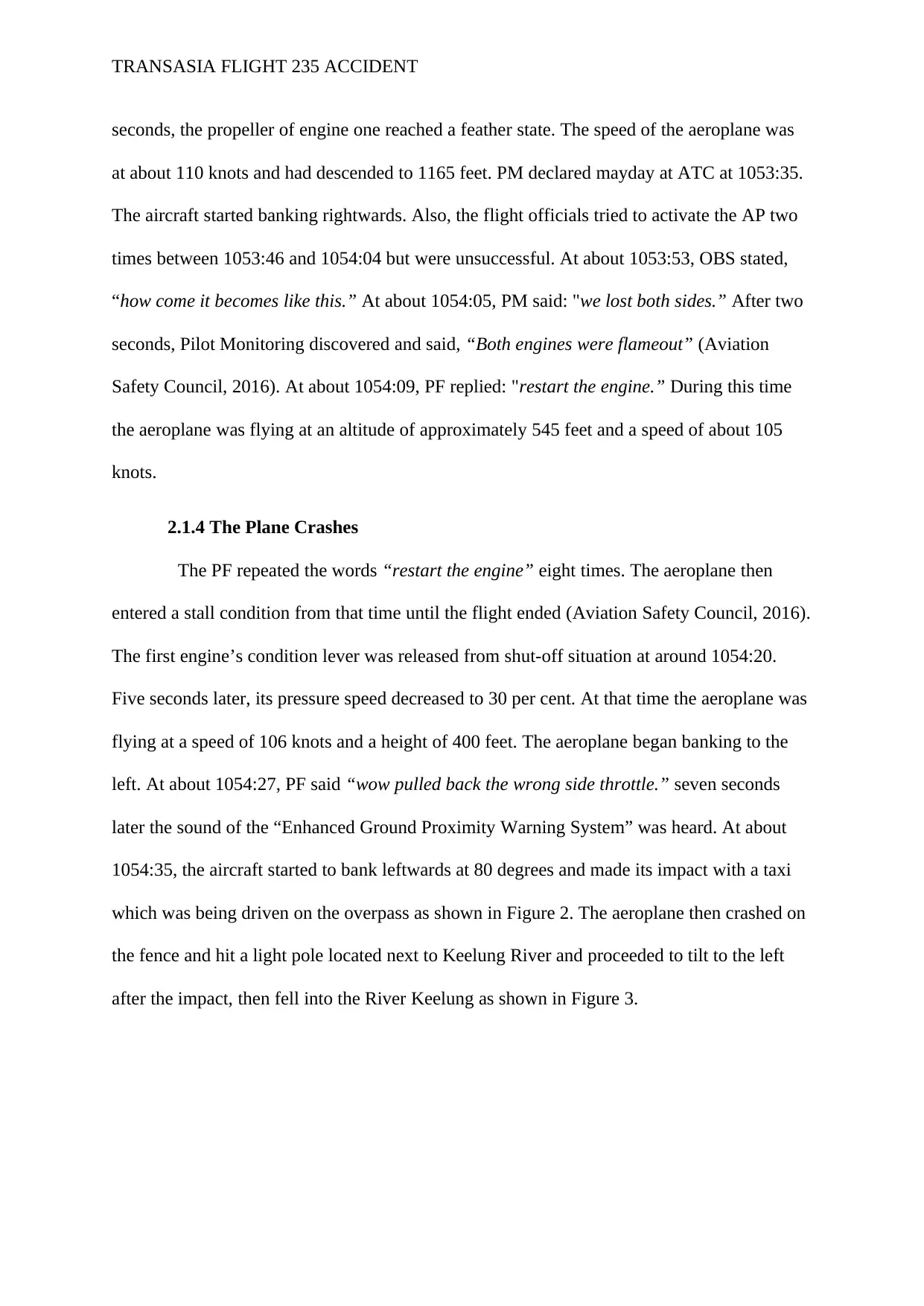
TRANSASIA FLIGHT 235 ACCIDENT
seconds, the propeller of engine one reached a feather state. The speed of the aeroplane was
at about 110 knots and had descended to 1165 feet. PM declared mayday at ATC at 1053:35.
The aircraft started banking rightwards. Also, the flight officials tried to activate the AP two
times between 1053:46 and 1054:04 but were unsuccessful. At about 1053:53, OBS stated,
“how come it becomes like this.” At about 1054:05, PM said: "we lost both sides.” After two
seconds, Pilot Monitoring discovered and said, “Both engines were flameout” (Aviation
Safety Council, 2016). At about 1054:09, PF replied: "restart the engine.” During this time
the aeroplane was flying at an altitude of approximately 545 feet and a speed of about 105
knots.
2.1.4 The Plane Crashes
The PF repeated the words “restart the engine” eight times. The aeroplane then
entered a stall condition from that time until the flight ended (Aviation Safety Council, 2016).
The first engine’s condition lever was released from shut-off situation at around 1054:20.
Five seconds later, its pressure speed decreased to 30 per cent. At that time the aeroplane was
flying at a speed of 106 knots and a height of 400 feet. The aeroplane began banking to the
left. At about 1054:27, PF said “wow pulled back the wrong side throttle.” seven seconds
later the sound of the “Enhanced Ground Proximity Warning System” was heard. At about
1054:35, the aircraft started to bank leftwards at 80 degrees and made its impact with a taxi
which was being driven on the overpass as shown in Figure 2. The aeroplane then crashed on
the fence and hit a light pole located next to Keelung River and proceeded to tilt to the left
after the impact, then fell into the River Keelung as shown in Figure 3.
seconds, the propeller of engine one reached a feather state. The speed of the aeroplane was
at about 110 knots and had descended to 1165 feet. PM declared mayday at ATC at 1053:35.
The aircraft started banking rightwards. Also, the flight officials tried to activate the AP two
times between 1053:46 and 1054:04 but were unsuccessful. At about 1053:53, OBS stated,
“how come it becomes like this.” At about 1054:05, PM said: "we lost both sides.” After two
seconds, Pilot Monitoring discovered and said, “Both engines were flameout” (Aviation
Safety Council, 2016). At about 1054:09, PF replied: "restart the engine.” During this time
the aeroplane was flying at an altitude of approximately 545 feet and a speed of about 105
knots.
2.1.4 The Plane Crashes
The PF repeated the words “restart the engine” eight times. The aeroplane then
entered a stall condition from that time until the flight ended (Aviation Safety Council, 2016).
The first engine’s condition lever was released from shut-off situation at around 1054:20.
Five seconds later, its pressure speed decreased to 30 per cent. At that time the aeroplane was
flying at a speed of 106 knots and a height of 400 feet. The aeroplane began banking to the
left. At about 1054:27, PF said “wow pulled back the wrong side throttle.” seven seconds
later the sound of the “Enhanced Ground Proximity Warning System” was heard. At about
1054:35, the aircraft started to bank leftwards at 80 degrees and made its impact with a taxi
which was being driven on the overpass as shown in Figure 2. The aeroplane then crashed on
the fence and hit a light pole located next to Keelung River and proceeded to tilt to the left
after the impact, then fell into the River Keelung as shown in Figure 3.
Paraphrase This Document
Need a fresh take? Get an instant paraphrase of this document with our AI Paraphraser
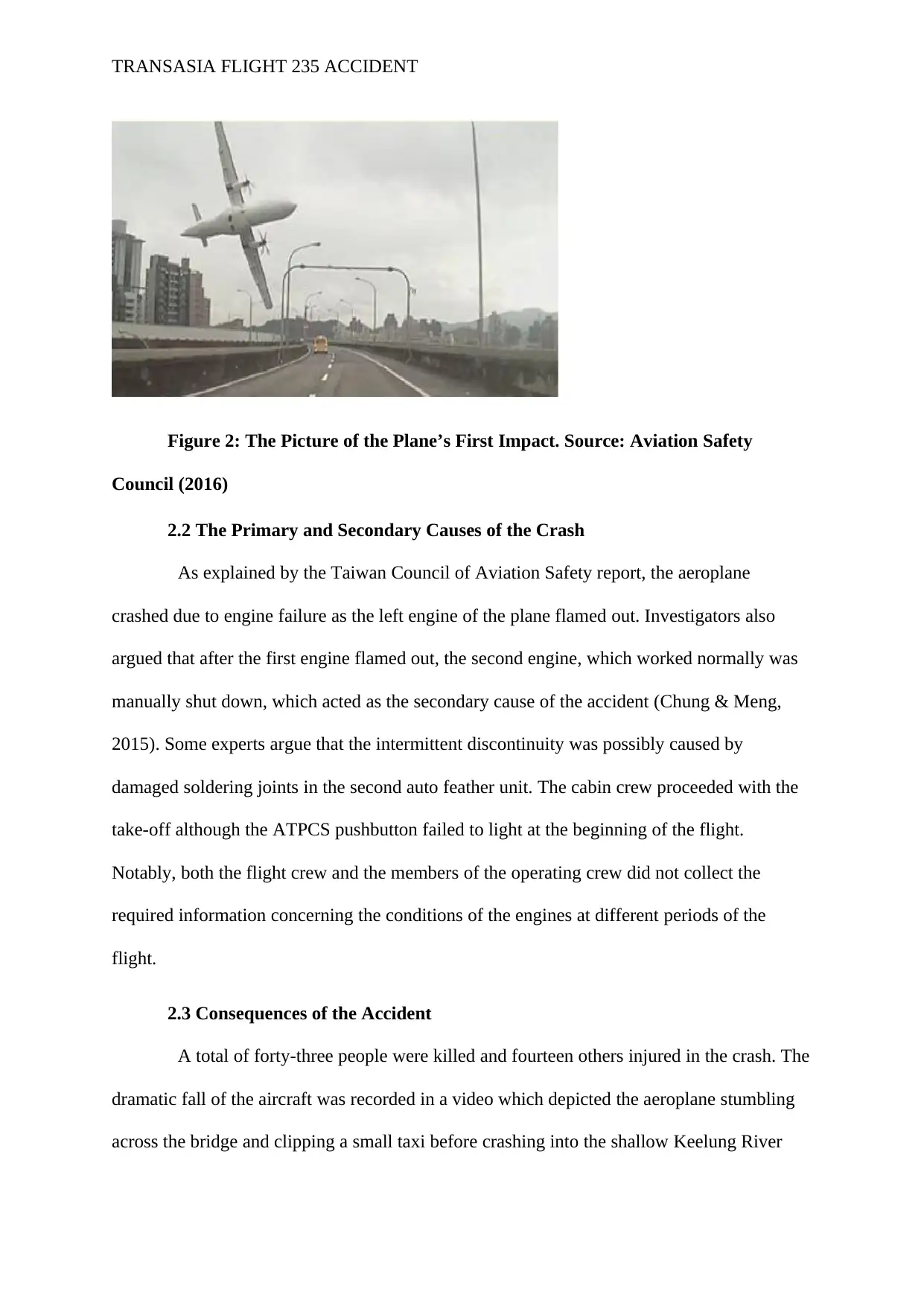
TRANSASIA FLIGHT 235 ACCIDENT
Figure 2: The Picture of the Plane’s First Impact. Source: Aviation Safety
Council (2016)
2.2 The Primary and Secondary Causes of the Crash
As explained by the Taiwan Council of Aviation Safety report, the aeroplane
crashed due to engine failure as the left engine of the plane flamed out. Investigators also
argued that after the first engine flamed out, the second engine, which worked normally was
manually shut down, which acted as the secondary cause of the accident (Chung & Meng,
2015). Some experts argue that the intermittent discontinuity was possibly caused by
damaged soldering joints in the second auto feather unit. The cabin crew proceeded with the
take-off although the ATPCS pushbutton failed to light at the beginning of the flight.
Notably, both the flight crew and the members of the operating crew did not collect the
required information concerning the conditions of the engines at different periods of the
flight.
2.3 Consequences of the Accident
A total of forty-three people were killed and fourteen others injured in the crash. The
dramatic fall of the aircraft was recorded in a video which depicted the aeroplane stumbling
across the bridge and clipping a small taxi before crashing into the shallow Keelung River
Figure 2: The Picture of the Plane’s First Impact. Source: Aviation Safety
Council (2016)
2.2 The Primary and Secondary Causes of the Crash
As explained by the Taiwan Council of Aviation Safety report, the aeroplane
crashed due to engine failure as the left engine of the plane flamed out. Investigators also
argued that after the first engine flamed out, the second engine, which worked normally was
manually shut down, which acted as the secondary cause of the accident (Chung & Meng,
2015). Some experts argue that the intermittent discontinuity was possibly caused by
damaged soldering joints in the second auto feather unit. The cabin crew proceeded with the
take-off although the ATPCS pushbutton failed to light at the beginning of the flight.
Notably, both the flight crew and the members of the operating crew did not collect the
required information concerning the conditions of the engines at different periods of the
flight.
2.3 Consequences of the Accident
A total of forty-three people were killed and fourteen others injured in the crash. The
dramatic fall of the aircraft was recorded in a video which depicted the aeroplane stumbling
across the bridge and clipping a small taxi before crashing into the shallow Keelung River
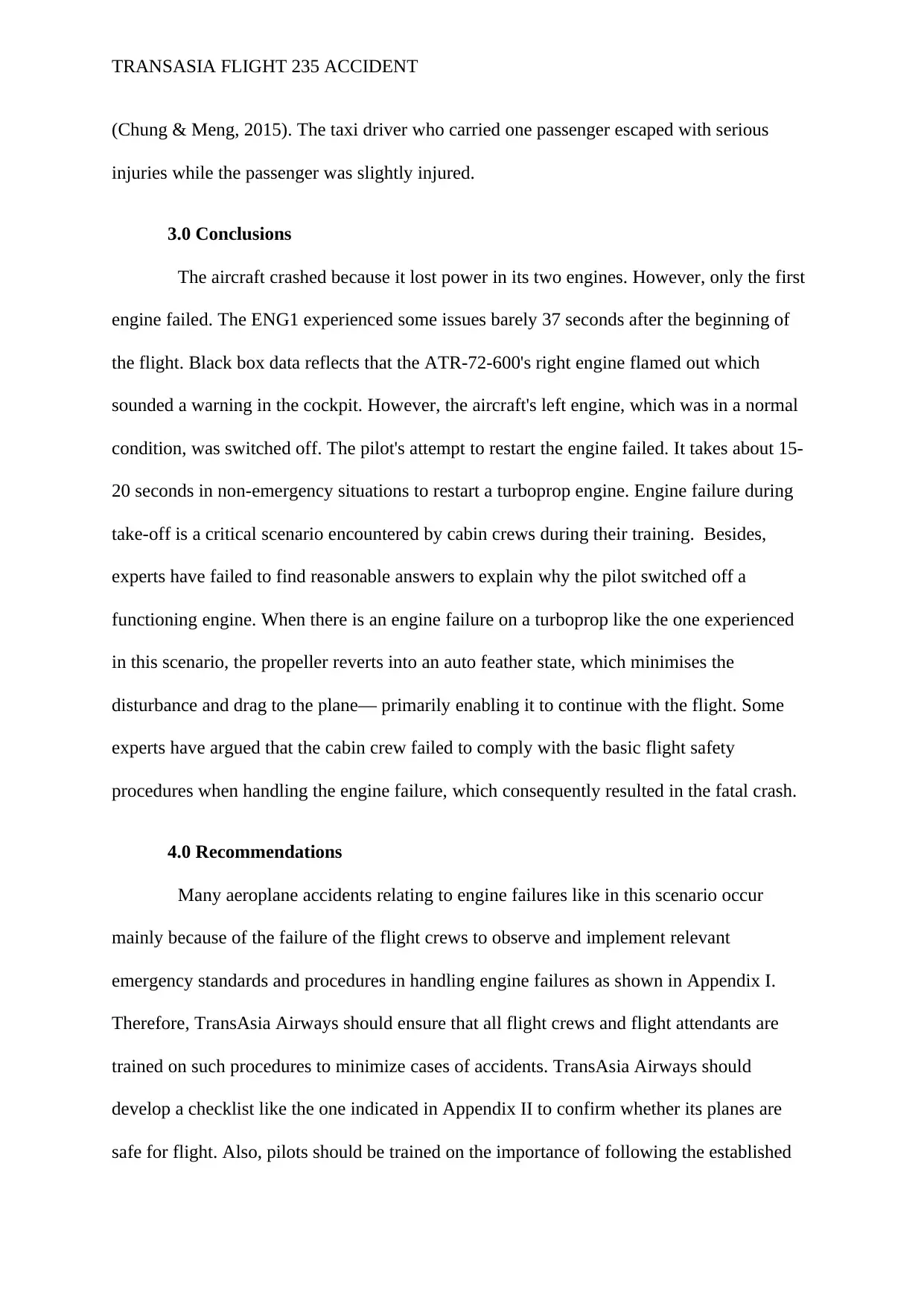
TRANSASIA FLIGHT 235 ACCIDENT
(Chung & Meng, 2015). The taxi driver who carried one passenger escaped with serious
injuries while the passenger was slightly injured.
3.0 Conclusions
The aircraft crashed because it lost power in its two engines. However, only the first
engine failed. The ENG1 experienced some issues barely 37 seconds after the beginning of
the flight. Black box data reflects that the ATR-72-600's right engine flamed out which
sounded a warning in the cockpit. However, the aircraft's left engine, which was in a normal
condition, was switched off. The pilot's attempt to restart the engine failed. It takes about 15-
20 seconds in non-emergency situations to restart a turboprop engine. Engine failure during
take-off is a critical scenario encountered by cabin crews during their training. Besides,
experts have failed to find reasonable answers to explain why the pilot switched off a
functioning engine. When there is an engine failure on a turboprop like the one experienced
in this scenario, the propeller reverts into an auto feather state, which minimises the
disturbance and drag to the plane— primarily enabling it to continue with the flight. Some
experts have argued that the cabin crew failed to comply with the basic flight safety
procedures when handling the engine failure, which consequently resulted in the fatal crash.
4.0 Recommendations
Many aeroplane accidents relating to engine failures like in this scenario occur
mainly because of the failure of the flight crews to observe and implement relevant
emergency standards and procedures in handling engine failures as shown in Appendix I.
Therefore, TransAsia Airways should ensure that all flight crews and flight attendants are
trained on such procedures to minimize cases of accidents. TransAsia Airways should
develop a checklist like the one indicated in Appendix II to confirm whether its planes are
safe for flight. Also, pilots should be trained on the importance of following the established
(Chung & Meng, 2015). The taxi driver who carried one passenger escaped with serious
injuries while the passenger was slightly injured.
3.0 Conclusions
The aircraft crashed because it lost power in its two engines. However, only the first
engine failed. The ENG1 experienced some issues barely 37 seconds after the beginning of
the flight. Black box data reflects that the ATR-72-600's right engine flamed out which
sounded a warning in the cockpit. However, the aircraft's left engine, which was in a normal
condition, was switched off. The pilot's attempt to restart the engine failed. It takes about 15-
20 seconds in non-emergency situations to restart a turboprop engine. Engine failure during
take-off is a critical scenario encountered by cabin crews during their training. Besides,
experts have failed to find reasonable answers to explain why the pilot switched off a
functioning engine. When there is an engine failure on a turboprop like the one experienced
in this scenario, the propeller reverts into an auto feather state, which minimises the
disturbance and drag to the plane— primarily enabling it to continue with the flight. Some
experts have argued that the cabin crew failed to comply with the basic flight safety
procedures when handling the engine failure, which consequently resulted in the fatal crash.
4.0 Recommendations
Many aeroplane accidents relating to engine failures like in this scenario occur
mainly because of the failure of the flight crews to observe and implement relevant
emergency standards and procedures in handling engine failures as shown in Appendix I.
Therefore, TransAsia Airways should ensure that all flight crews and flight attendants are
trained on such procedures to minimize cases of accidents. TransAsia Airways should
develop a checklist like the one indicated in Appendix II to confirm whether its planes are
safe for flight. Also, pilots should be trained on the importance of following the established
⊘ This is a preview!⊘
Do you want full access?
Subscribe today to unlock all pages.

Trusted by 1+ million students worldwide
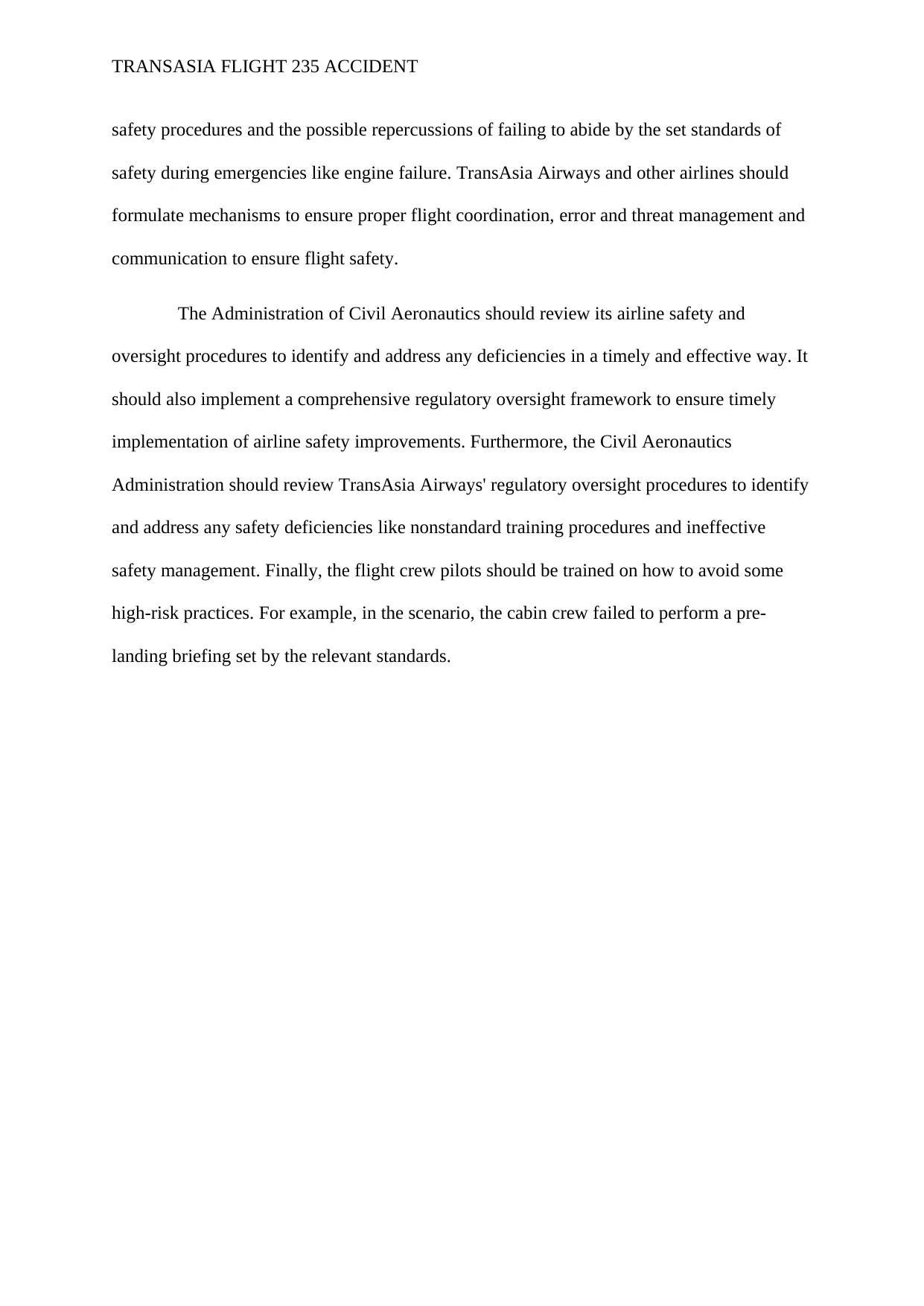
TRANSASIA FLIGHT 235 ACCIDENT
safety procedures and the possible repercussions of failing to abide by the set standards of
safety during emergencies like engine failure. TransAsia Airways and other airlines should
formulate mechanisms to ensure proper flight coordination, error and threat management and
communication to ensure flight safety.
The Administration of Civil Aeronautics should review its airline safety and
oversight procedures to identify and address any deficiencies in a timely and effective way. It
should also implement a comprehensive regulatory oversight framework to ensure timely
implementation of airline safety improvements. Furthermore, the Civil Aeronautics
Administration should review TransAsia Airways' regulatory oversight procedures to identify
and address any safety deficiencies like nonstandard training procedures and ineffective
safety management. Finally, the flight crew pilots should be trained on how to avoid some
high-risk practices. For example, in the scenario, the cabin crew failed to perform a pre-
landing briefing set by the relevant standards.
safety procedures and the possible repercussions of failing to abide by the set standards of
safety during emergencies like engine failure. TransAsia Airways and other airlines should
formulate mechanisms to ensure proper flight coordination, error and threat management and
communication to ensure flight safety.
The Administration of Civil Aeronautics should review its airline safety and
oversight procedures to identify and address any deficiencies in a timely and effective way. It
should also implement a comprehensive regulatory oversight framework to ensure timely
implementation of airline safety improvements. Furthermore, the Civil Aeronautics
Administration should review TransAsia Airways' regulatory oversight procedures to identify
and address any safety deficiencies like nonstandard training procedures and ineffective
safety management. Finally, the flight crew pilots should be trained on how to avoid some
high-risk practices. For example, in the scenario, the cabin crew failed to perform a pre-
landing briefing set by the relevant standards.
Paraphrase This Document
Need a fresh take? Get an instant paraphrase of this document with our AI Paraphraser
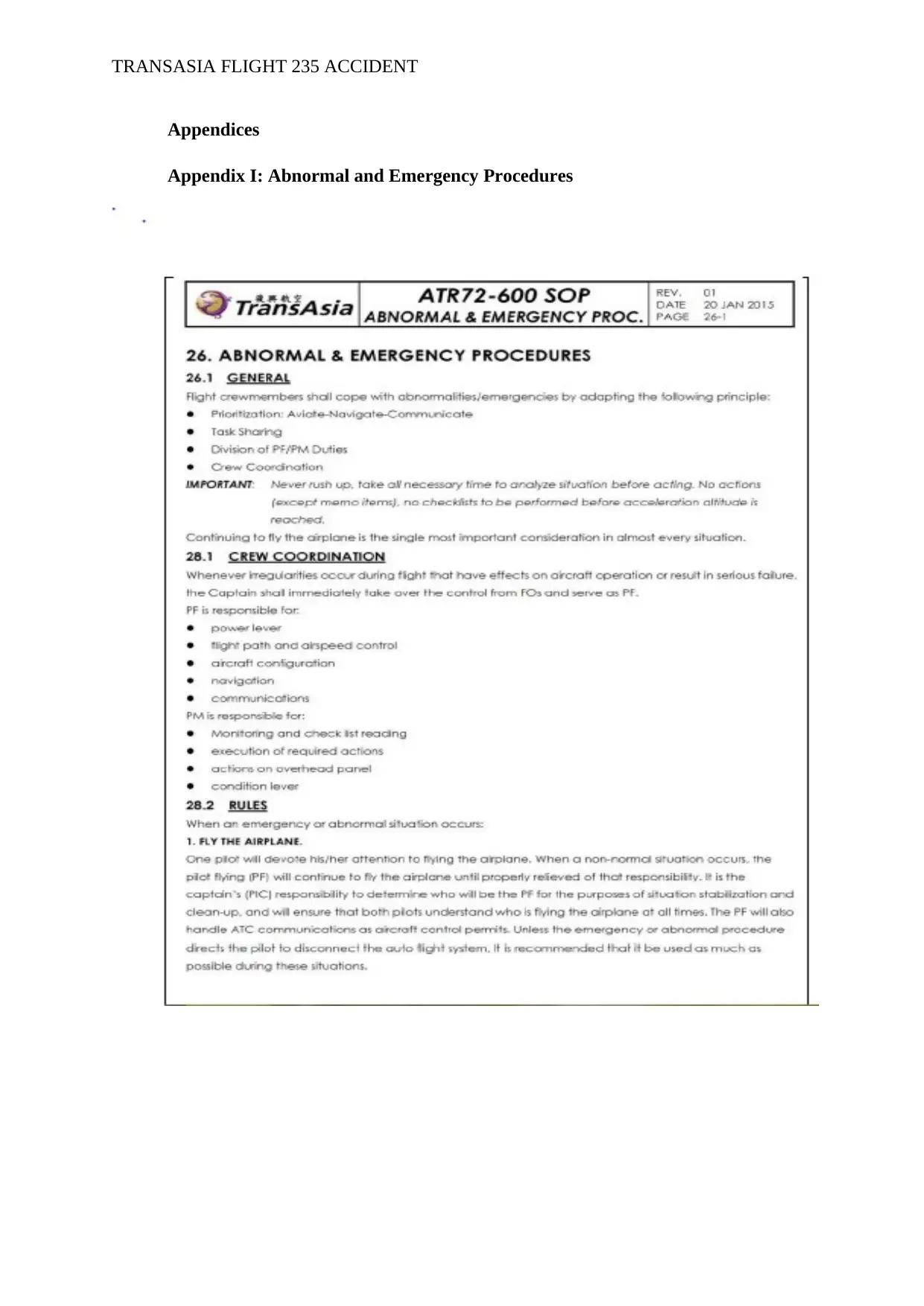
TRANSASIA FLIGHT 235 ACCIDENT
Appendices
Appendix I: Abnormal and Emergency Procedures
Appendices
Appendix I: Abnormal and Emergency Procedures
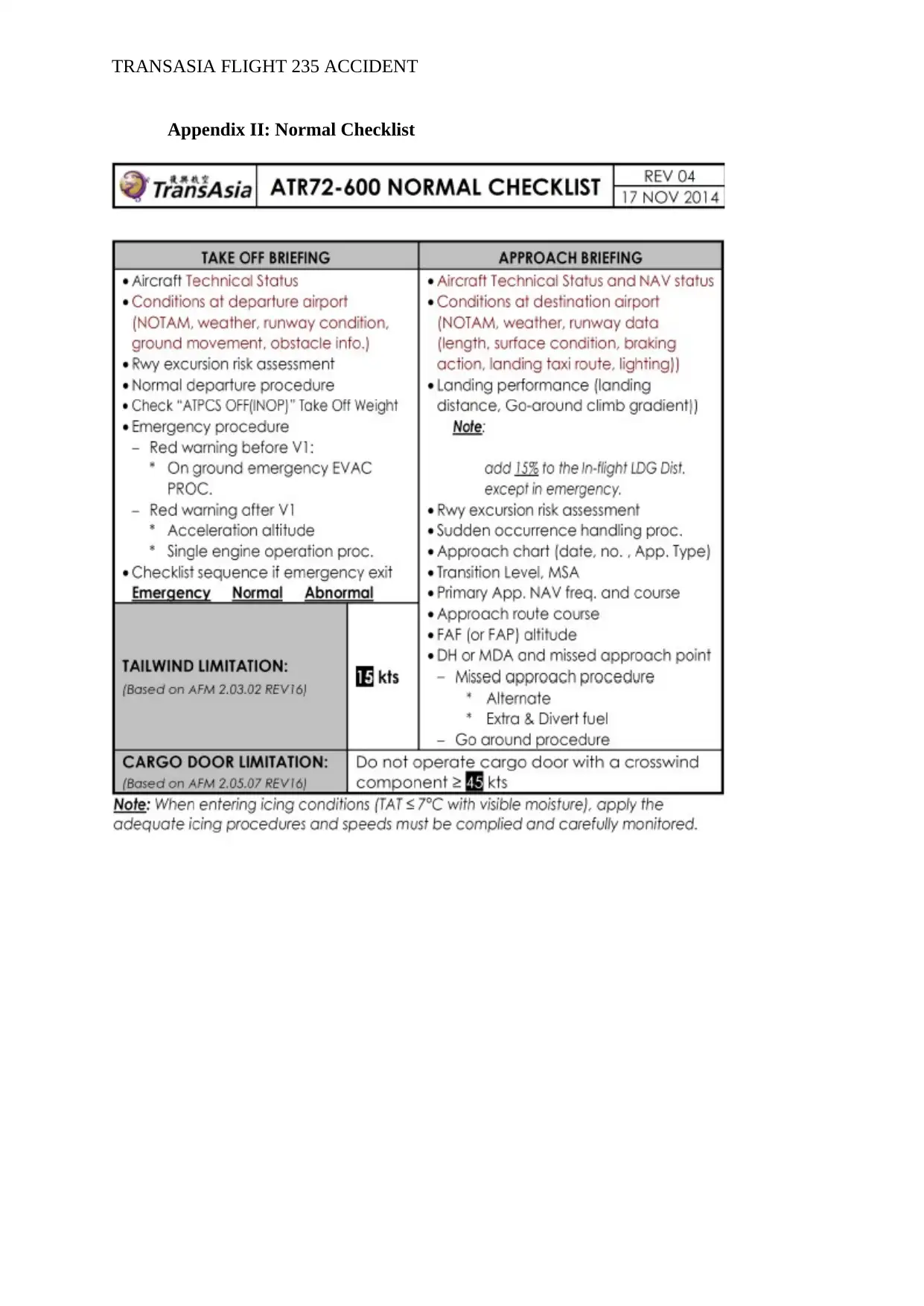
TRANSASIA FLIGHT 235 ACCIDENT
Appendix II: Normal Checklist
Appendix II: Normal Checklist
⊘ This is a preview!⊘
Do you want full access?
Subscribe today to unlock all pages.

Trusted by 1+ million students worldwide
1 out of 13
Your All-in-One AI-Powered Toolkit for Academic Success.
+13062052269
info@desklib.com
Available 24*7 on WhatsApp / Email
![[object Object]](/_next/static/media/star-bottom.7253800d.svg)
Unlock your academic potential
Copyright © 2020–2025 A2Z Services. All Rights Reserved. Developed and managed by ZUCOL.